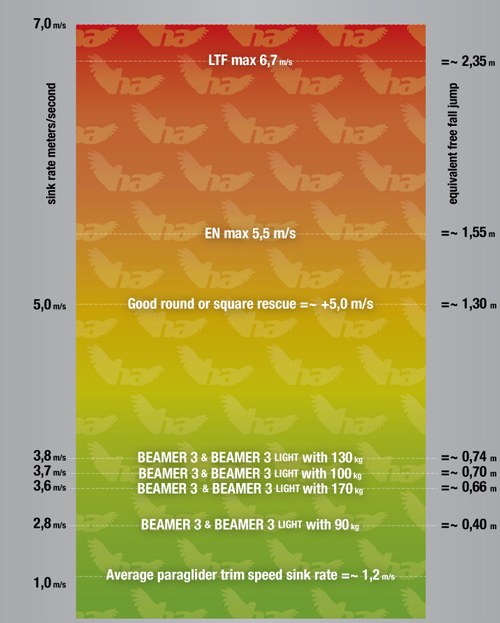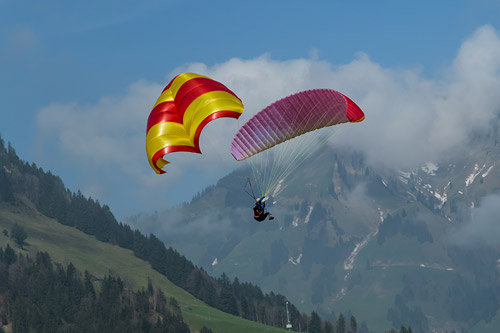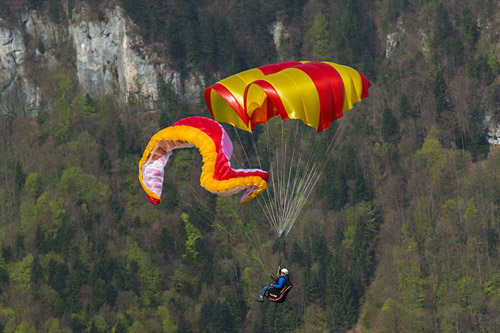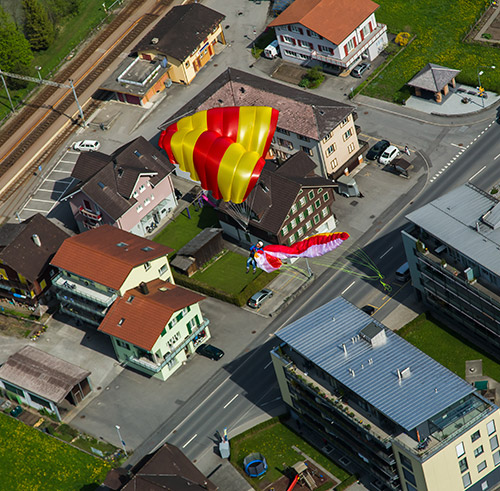High-Adventure Beamer 3 Light Reserve Parachute Maximum safety since 1995
The BEAMER 3 light is a fully-fledged BEAMER 3 but thanks to its weight-optimised materials, it is more than 400 grams lighter. As well as less weight, it also has less volume. At 1370 grams the BEAMER 3 light is one of the lightest steerable parachutes on the market.
Technical data
| Size | 100 | 130 | 170 |
|---|---|---|---|
| Max load | 90 (100)* kg | 130 kg | 170 kg |
| Flat area | 35.47 m2 | 41.75 m2 | 58 m2 |
| Weight | 1180 g | 1370 g | 2200 g |
| Weight with POD | 1230 g | 1420 g | 2240 g |
| Riser extension kit for front mount connection, pair |
20 g | 20 g | 20 g |
| Sink rate (EN Test) -loaded @ 100kg -loaded @ 130kg -loaded @ 170kg |
3.7 m/sec – – |
– 3.8 m/sec – |
– – 3.6 m/sec |
| Opening time (EN Test) | 2 sec | 2 sec | 2 sec |
| Packing volume | 3324 ccm | 3837 ccm | 6054 ccm |
| Number of panels | 16 | 18 | 18 |
| Number of middle lines | 8×2 | 9×2 | 10×2 |
| Type Certificate | EP/RG 104.2013 | EP/RG 101.2013 | EP 281.2019 |
| Applied test guideline/standards | EN 12491:2001 / 2.DV LuftGerPV §1, Nr.7c |
EN 12491:2001 / 2.DV LuftGerPV §1, Nr.7c |
EN 12491:2001 / 2.DV LuftGerPV §1, Nr.7c |
* Extended weight range for size 100 (100 kg).
Although the EN/LTF flight tests showed a 3.7 m/sec descent rate at 100 Kg, our own experience also tells us that highly loaded Rogallos, like conventional reserve parachutes, can lead to mirror flying or down-planing when combined with the paraglider. This mainly happens with very stable and collapse resistant school gliders, or in very steady throwing conditions such as training openings over water. The EN/LTF practical tests are always carried out in separated configuration – without the troublesome paraglider. When developing our Rogallo reserve parachutes we focus a lot of attention on the overall functioning spectrum, above all in connected condition (when the paraglider is not cut away).
Despite the positive flight tests at more than 100kg we recommend that the extended weight range is only for use by experienced “Rogallo pilots”, or in conjunction with a reliable cut-away system.
The top four Beamer 3 light characteristics
Fast opening
Opening time is the most important reserve criterion. If a reserve has to be thrown at low altitude – and that is often the case – a single second can make all the difference. The Beamer 3’s special shape and particular folding technique help it open up to 50% faster than normal round canopies; the Beamer 3 light is setting EN Test records.

Low sink speed
Assuming a reserve is open with its paraglider in a stable situation the next most important thing is sink speed. Low wing loading and modest forward speed give the Beamer 3 light an unrivalled low sink rate. The EN certification authority has confirmed a sink rate of 3.9 m/s at maximum weight of 130 kg (without the paraglider). The additional braking effect of a paraglider reduces this value to less than 3m/s.
Stable flight
When developing a Rogallo our main focus is how it works with the paraglider. After reserve opening the paraglider can stay attached (the usual emergency situation – no quick release/cutaway). Here the Beamer 3 light really plays its trump card. After a fast opening the Beamer 3 light quickly takes control. It goes into very slow forward flight and therefore does not encourage the paraglider to disturb it. The Beamer 3 light achieves Its stability, among other things, by its low wing loading.
As a special feature we elected to further develop the braked opening configuration for the Rogallo – successfully applied to the Beamer 2. This results in even less forward speed and provides what most pilots need – the advantages of a round canopy’s vertical flightpath, plus those of a steerable forwards-flying Rogallo. For example, if the Beamer opens alongside a rock face, or in strong wind, its initial descent will be almost vertical. Then, after its steering lines have been activated, the Rogallo’s forward speed can be used. If the pilot has enough height he can then steer the Beamer 3 light away from danger (e.g. rocks, water, buildings etc.).
The braked opening configuration automatically includes another important effect: what is known as ‘downplaning’ is effectively prevented. This scissoring problem happens when paraglider and reserve (round canopies too) both develop forward speed while pulling against each other, and both head straight downwards. This raises the sink speed markedly, and the risk of injury dramatically. The Beamer 3’s pre-braking and its large area oppose this: the braked Rogallo surface refuses to be accelerated in this way.
Steering and flying forwards – the Beamer’s speciality!
Paraglider under tow: In real-life reserve-throwing situations the paraglider can become a massive problem. In many cases the paraglider is already collapsed, both during and after reserve opening, and therefore prevented from flying. Here the Beamer 3 light descent is a pure pleasure. The canopy reacts immediately to steering commands and sinks at its slowest rate. When the reserve is thrown while the paraglider is flying normally, such as during SIV training, the descent characteristics of both Rogallo and round reserve can be affected. If the paraglider reopens itself during a reserve descent it can easily be prevented from flying by B-stall, or reefing in. This will greatly improve steerability. Countless examples in practice confirm the problem-free behaviour of all Beamers in every possible situation.
Paraglider tangled up in the Rogallo lines: Here pilots with a cutaway system can fully appreciate the Beamer 3’s qualities. Glide performance doubles – with slightly increased sink speed. Cutaway carabiners mainly make sense in competition flying (more risk of collision) or for acro. A suitable seatbelt cutter, secured on a long bungee, would do the same job in an emergency.
Extended Weight Range
Although the EN/LTF flight tests showed a 3,7 m/sec descent rate at 100 Kg, our own experience also tells us that highly loaded Rogallos, like conventional reserve parachutes, can lead to mirror flying or down-planing when combined with the paraglider. This mainly happens with very stable and collapse resistant school gliders, or in very steady throwing conditions such as training openings over water. The EN/LTF practical tests are always carried out in separated configuration – without the troublesome paraglider. When developing our Rogallo reserve parachutes we focus a lot of attention on the overall functioning spectrum, above all in connected condition (when the paraglider is not cut away).
Despite the positive flight tests at more than 100kg we recommend that the extended weight range is only for use by experienced “Rogallo pilots”, or in conjunction with a reliable cut-away system.
Technical differences between Beamer 3 light and Beamer 2
The Beamer 3 light has a completely new, simplified and user-friendly riser system. This reduces the chance of twists and makes installation easier. Packers will appreciate this: Steering line shortening for the braked opening stage is largely self-explanatory. The risers are set up for shoulder mounting. Short extensions are needed for main carabiner (front container) attachment.
Size, wing shape, lines and flying behavior of the Beamer 3 light remain unchanged from the Beamer 2. Construction details and the new risers reduce the weight from (very light!) 1950 to 1370 gm for an area of 42 m2: more than half a kilo lighter than the Beamer 2!
By using the latest high-tech materials we put the Beamer 3 light on a drastic weight loss program. Result: another quarter of the weight off! The Beamer 3 light is in the same league as modern lightweight round canopies when it comes to volume – but it’s not in the “one-shot rescue” category. The Beamer 3 light’s ultralight fabric and lines are also suitable for SIV training and practice throwing over water but are not recommended for regular use of aerobatic pilots.
Questions and answers
Will the Beamer fit in any harness or front container?
Can I do safety training over water with the Beamer 3?
Downloads
- Owner’s Manual EN (PDF)
- Betriebsanleitung DE (PDF)
- Manuel Utilisateur FR (PDF)
- Manual de usuario ES (PDF)









Reviews
There are no reviews yet.